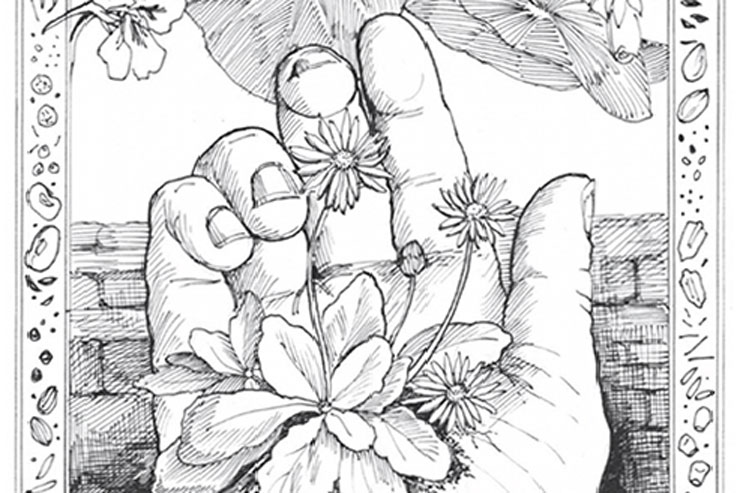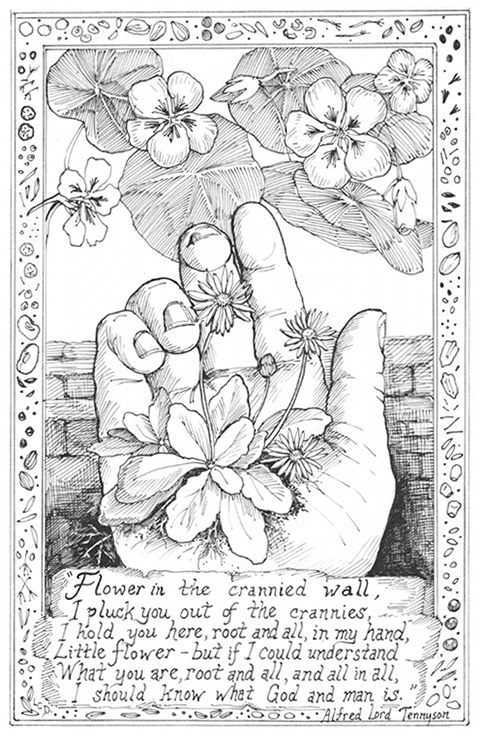
There are many quotes in today’s piece from Diana Wells dating back as far as 1597 about the premise that what we are cultivating is a garden of miracles in our backyards. But the quote I think I like the most comes from Diana herself: “How lucky we gardeners are, especially in Springtime, to be able to concentrate on miracles.”
As she reminds us continually throughout the piece, it may be that our love for our garden is built on our love of these wonders; From finding sprouts in the cracks of sidewalks, to watching bulbs re-bloom year after year.
In her story, Diana shares a time she found a tiny tomato plant underneath her picnic table. “All right, you silly plant,” she said, and dug it up. “I kept it in a pot all winter. As if in gratitude, it grew and grew, and I had to prune it until it could go outside—where there was no stopping it. Eventually, it reached 15 feet high and 8 feet across (truly), covering everything around it and filling the porch gutter,” she writes.
Decades could pass and I’m sure Diana, and now I, will remember small miracles like these. The little tomato plant that could.
Discover 7 top tips for growing, harvesting, and enjoying tomatoes from your home garden—when you access the FREE guide The Best Way to Grow Tomatoes, right now!
Celebrate Your Garden of Miracles
This story comes from our archive that spans over 30 years and includes more than 130 magazine issues of GreenPrints. Pieces like these that inject gardening history into everyday life lessons always brighten up my day, and I hope it does for you as well. Enjoy!
A garden is a miracle and a haven. All you have to do is . . .


Look
By Diana Wells
“Who would therefore look dangerously up at Planets, that might safely looke downe at Plantes?” asked John Gerard in his famous Herball of 1597.
What a comfort the garden can be in a turbulent, sometimes puzzling world. When Gerard was comforting himself with “the earth appareled with plants, as with a robe of embroidered worke, set with Orient pearles and garnished with great diversitie of rare and costly jewels,” views of his world were being turned over. His orderly universe was challenged by the shattering concept of contemporary scientists that, far from being the stable center of all things, the earth itself was moving and its companions, the “wandering stars” (planets) didn’t even travel in perfect circles. The flowers, though, bloomed safely below—as they always had.
Gardeners, like little children and poets, can enter into a small universe beneath them:
To see a World in a Grain of Sand
And Heaven in a Wild Flower
Hold Infinity in the palm of your hand
And Eternity in an hour
wrote William Blake. How lucky we gardeners are, especially in springtime, to be able to concentrate on miracles. Karel Capek, who wrote The Gardener’s Year in the late 1920s, lived in turbulent times: Hitler appointed Himmler and Goebbels as Nazi party leaders. Stalin was in power in the U.S.S.R. Meanwhile, Edwin Hubble discovered galaxies beyond the Milky Way and showed that they were moving away from the earth, and the universe itself is expanding.
Karel Capek was busy planting seeds, first marveling to his readers at the different seeds themselves: Some are “like blood-red fleas without legs;” others “thin like needles.” They can be “big like cockroaches,” and tiny “like specks of dust.” Big seeds don’t necessarily grow into large plants, or small ones into small plants. “I simply don’t believe it,” he writes. The world outside goes on; Capek is absorbed watching his seeds. He waits for the soil to be “silently forced apart,” and the tiny plant to emerge, miraculously “lifting the seed on its head like a cap.”
It’s the time of year for all of us to be planting seeds. As usual, I’ll put in a lot of nasturtiums, which must be the most rewarding flowers on earth: easy to grow, quick to flower—and spreading shield-like leaves that cover all garden mistakes! When first they came to Spain (1569), Nicholas Monardes described them in his book, New Founde Worlde. Each petal, he wrote, has a spot on it “like a droppe of bloode, so red and so firmly kindled in couller that it could not be more.”
Now I wonder how many of us (including me) have really noticed that red spot? The impressionist painter Claude Monet relied heavily on nasturtiums in his famous garden at Giverny, and he painted them, too, in glorious impressionist color. Did he notice Monardes’s spot? Anyway, this year I’m going to look closely for it, although maybe it has been hybridized out. But I’m going to look, really look down at the flowers in my garden.
Most flowers look up at the sun, their source of light and life. When I plant beans, they’ll shoot straight up towards the heavens. Unlike many of us, they don’t (I presume) wake up at 4:00 a.m. and start thinking of black holes, inter-space travel overtaking time, and the possible destruction of the earth’s atmosphere. They don’t presumably worry about their grandchildren, potential health issues, or their identity being stolen.
(I don’t worry much about my own identity being stolen. Who would want to be me, pottering around without an iPad, without a television, without a camera, talking—as you’ll see—to tomatoes? I don’t think there’d be many takers!) I don’t grow all my plants from seed—especially not tomatoes. Last year, however, when I was clearing up the garden in late October, I came across a tiny tomato seedling under our picnic table. What could I do? “All right, you silly plant,” I said, and dug it up. I kept it in a pot all winter. As if in gratitude, it grew, and grew, and I had to prune it until it could go outside—where there was no stopping it. Eventually, it reached 15 feet high and 8 feet across (truly), covering everything around it and filling the porch gutter. It produced an abundance of small yellow tomatoes—not the best I have ever eaten, I admit. But it had already made a miracle. What more could I ask of it?
This year I’ll get some regular tomato plants, too. They come small, each one smaller by far than the fruit I hope to harvest from it. Like the poet Tennyson, I’ll cup the tiny plants in my hand and think about it all. Tennyson wasn’t gardening, but probably strolling when he spotted a Flower in a Crannied Wall. We know he wasn’t on a cell phone (in 1869), so he was looking and his hands were free:
Flower in the crannied wall,
I pluck you out of the crannies
I hold you here, root and all, in my hand,
Little flower—but if I could understand
What you are, root and all, and all in all,
I should know what God and man is.
Yes, these are turbulent times, and I for one don’t understand much of what goes on in the world outside my garden. I’m scared of my word processor (which has behaved well so far today) and can’t cope with email. I still like to pay bills by check. And if I’m depressed, I go into the garden to potter around.
And look. ❖
By Diana Wells, published originally in 2015, in GreenPrints Issue #101. Illustrations by Linda Cook Devona

Did you enjoy this gardening history story? Please tell us how it made you feel when you read this heart-warming piece. Do you feel like you have a garden of miracles too?
Discover 7 top tips for growing, harvesting, and enjoying tomatoes from your home garden—when you access the FREE guide The Best Way to Grow Tomatoes, right now!




